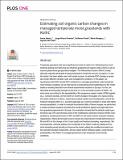Por favor, use este identificador para citar o enlazar a este item:
http://hdl.handle.net/10261/251058COMPARTIR / EXPORTAR:
 SHARE SHARE
 CORE
BASE CORE
BASE
|
|
| Visualizar otros formatos: MARC | Dublin Core | RDF | ORE | MODS | METS | DIDL | DATACITE | |

| Título: | Estimating soil organic carbon changes in managed temperate moist grasslands with RothC |
Autor: | Jebari, Asma CSIC ORCID; Álvaro-Fuentes, Jorge CSIC ORCID ; Pardo,Guillermo; Almagro, María CSIC ORCID; Prado, Agustín del | Fecha de publicación: | ago-2021 | Editor: | Public Library of Science | Citación: | Jebari A, Álvaro-Fuentes J, Pardo G, Almagro M, Prado A. Estimating soil organic carbon changes in managed temperate moist grasslands with RothC. PLOS One 16 (8): e0256219 (2021) | Resumen: | Temperate grassland soils store significant amounts of carbon (C). Estimating how much livestock grazing and manuring can influence grassland soil organic carbon (SOC) is key to improve greenhouse gas grassland budgets. The Rothamsted Carbon (RothC) model, although originally developed and parameterized to model the turnover of organic C in arable topsoil, has been widely used, with varied success, to estimate SOC changes in grassland under different climates, soils, and management conditions. In this paper, we hypothesise that RothC-based SOC predictions in managed grasslands under temperate moist climatic conditions can be improved by incorporating small modifications to the model based on existing field data from diverse experimental locations in Europe. For this, we described and evaluated changes at the level of: (1) the soil water function of RothC, (2) entry pools accounting for the degradability of the exogenous organic matter (EOM) applied (e.g., ruminant excreta), (3) the month-on-month change in the quality of C inputs coming from plant residues (i.e above-, below-ground plant residue and rhizodeposits), and (4) the livestock trampling effect (i.e., poaching damage) as a common problem in areas with higher annual precipitation. In order to evaluate the potential utility of these changes, we performed a simple sensitivity analysis and tested the model predictions against averaged data from four grassland experiments in Europe. Our evaluation showed that the default model’s performance was 78% and whereas some of the modifications seemed to improve RothC SOC predictions (model performance of 95% and 86% for soil water function and plant residues, respectively), others did not lead to any/or almost any improvement (model performance of 80 and 46% for the change in the C input quality and livestock trampling, respectively). We concluded that, whereas adding more complexity to the RothC model by adding the livestock trampling would actually not improve the model, adding the modified soil water function and plant residue components, and at a lesser extent residues quality, could improve predictability of the RothC in managed grasslands under temperate moist climatic conditions. | Descripción: | 23 Pags.- 8 Tabls.- 2 Figs. © 2021 Jebari et al. This is an open access article distributed under the terms of the Creative Commons Attribution License, which permits unrestricted use, distribution, and reproduction in any medium, provided the original author and source are credited. | Versión del editor: | https://doi.org/10.1371/journal.pone.0256219 | URI: | http://hdl.handle.net/10261/251058 | DOI: | 10.1371/journal.pone.0256219 | E-ISSN: | 1932-6203 |
| Aparece en las colecciones: | (EEAD) Artículos |
Ficheros en este ítem:
| Fichero | Descripción | Tamaño | Formato | |
|---|---|---|---|---|
| Alvaro-FuentesJ_PLOSOne_2021.pdf | 929,35 kB | Adobe PDF |  Visualizar/Abrir |
CORE Recommender
SCOPUSTM
Citations
6
checked on 22-abr-2024
WEB OF SCIENCETM
Citations
6
checked on 18-feb-2024
Page view(s)
80
checked on 23-abr-2024
Download(s)
89
checked on 23-abr-2024
Google ScholarTM
Check
Altmetric
Altmetric
Este item está licenciado bajo una Licencia Creative Commons

